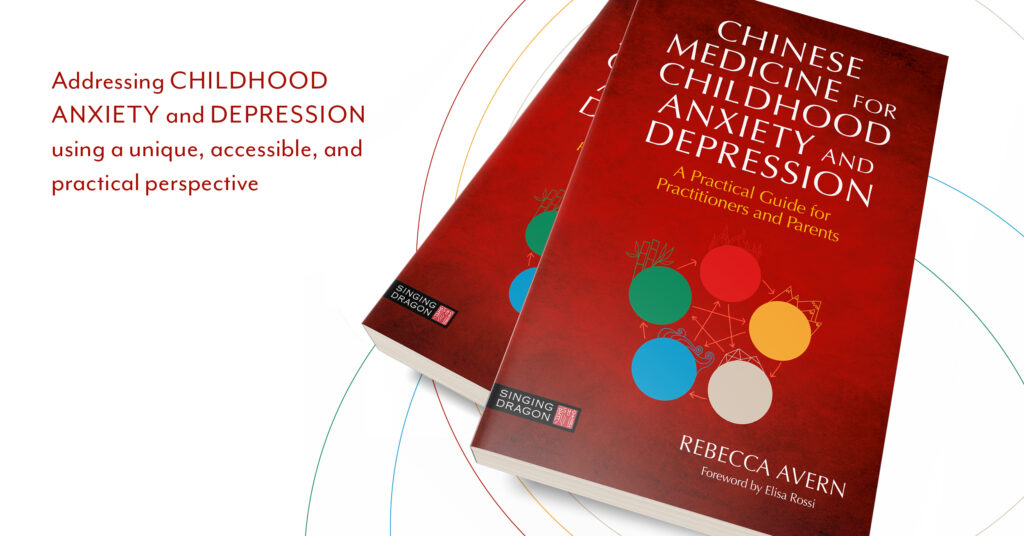
My first book, Acupuncture for Babies, Children and Teenagers, has a chapter on anxiety and depression which is purely for acupuncturists to guide them in treating it in the clinic. I realised over the years, however, that there is so much that is helpful in the way that Chinese Medicine understands people which can be applied outside of the clinic. This wisdom can be used by parents, at home, to make changes which will support their child’s mental-emotional health. That is why I chose to write a second book, for parents and practitioners.
One of the many tools we have to support young people whose mental health is struggling, is our ability to make a ‘bespoke’ diagnosis of exactly the nature of each person’s distress. ‘Anxiety’ and ‘Depression’ are necessary but limiting labels that are used to describe a multitude of different feeling states. Using the Five Element model, we can begin to understand that one child’s anxiety is very different from the next, and that each child’s depression will have a unique flavour to it.
Let’s take a look at each Element to illustrate this.
FIRE ELEMENT
The Fire Element governs a young person’s relationships with others. When the Fire Element is out of balance, a child or teenager may feel unloved and unloveable. Of course, the vast majority of the time we hope, she is loved but when her iFire goes out, it becomes very hard to be able to absorb the love she is given. Her anxiety may be ‘social anxiety’ and is centred around what she feels others might think about her. This may lead her to avoid social situations, or to torment herself afterwards wondering if she said the right thing, looked the right way or behaved appropriately.
EARTH ELEMENT
The Earth Element determines the degree to which a young person feels looked after, nourished and understood by others. When the Earth Element is out of balance, a child or teenager may feel that nobody understands him. Even though he may be very well cared for and looked after, he struggles to absorb the care or the feels he is not being cared for in the right way. He may feel overwhelmed easily and that he can’t cope with what he has to do. He will be prone to worry and thoughts may easily get trapped in his head, especially at bedtime.
METAL ELEMENT
The Metal Element helps to give a young person a feel that they are worthy, and gives them a sense of self-worth. When the Metal Element is out of balance, a child or teenager often feels they are not good enough. They may have strong self-critical voices and feel that they never quite live up to the standards expected of them. If they have low feelings, these may have a flavour of resignation about them, as if they have lost the feeling of being inspired by life.
WATER ELEMENT
The Water Element enables a young person to feel safe in the world. When it becomes imbalanced, it can lead to a feeling that is more closely aligned with the traditional sense of ‘anxiety’. The child or teenager may feel agitated, on edge and hyper-vigilant. They may easily develop catastrophic fantasies, imagining that the worst possible scenario is also the most likely one in every situation. Although an imbalanced Water Element may be linked to phobias, often the young person’s anxiety is pervasive and not linked to a particular aspect of life.
WOOD ELEMENT
The Wood Element enables a young person to forge a vision of their path through life and a sense of their future. It inspires them to set goals, develop and grow as a person. When it is out of balance, the young person may feel stuck and lose their sense of what their future looks like. They often complain of feeling hopeless and like there is no point anymore. If they are anxious, their anxiety is likely to be focussed on their schedule. They feel stressed by everything that has to be done and keeping on top of it all.
The above is an extremely simplified and brief overview, but gives a sense of the way the Five Element model can be used to understand the nuances of a young person’s emotional suffering. The wonderful thing about this system is that, apart from giving the child acupuncture to help bring balance to the Element which is struggling, it can also be used to help identify aspects of the child’s life which are contributing to their difficulties. For example, a Metal child may need time alone after being surrounded by others at school. A Wood child will often benefit emotionally from being physically active. An Earth child’s emotional state may be more affected by diet than another childs.
In my book, I discuss in a lot of detail how we can spot which Element is struggling, and how we can guide children and their parents to create a life which promotes mental-emotional thriving, rather than one which detracts from it. A young person’s emotional state is intertwined with the fabric of their life. Moreover, each young person will respond to life according to their Five Element constitution. Once we begin to understand how this works, anxiety and depression can become a thing of the past!
Rebecca’s book Chinese Medicine for Childhood Anxiety and Depression is available to order now.
If you liked this article, why not join our mailing list to receive exclusive content and discounts? Sign up to the mailing list here.